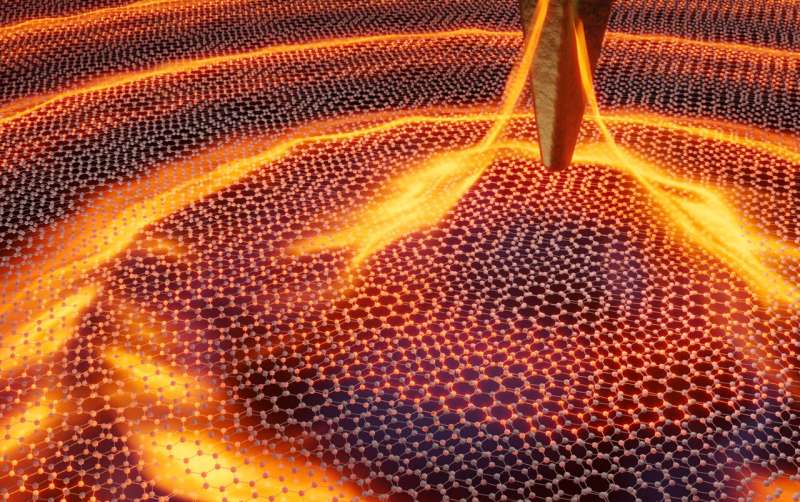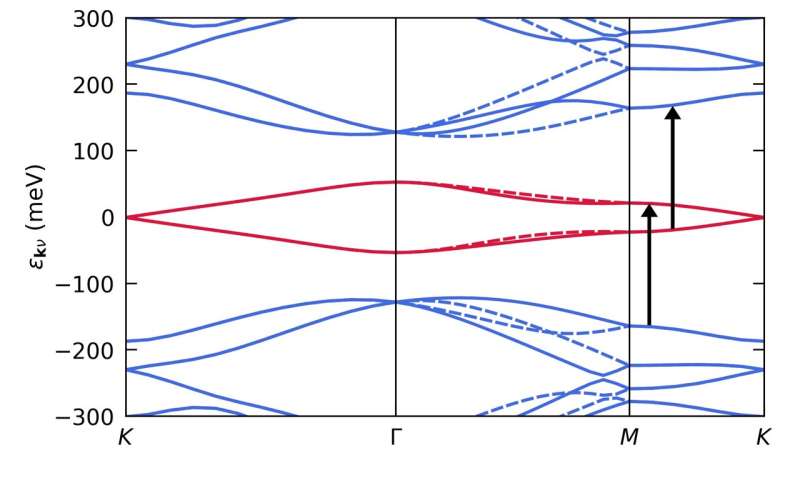October 28, 2021 feature
Researchers observe interband collective excitations in twisted bilayer graphene

Twisted bilayer graphene is a carbon-based, two-dimensional (2D) material comprising two graphene layers. Although many scientists have recently started exploring its potential for superconductivity and magnetism, so far, there have been very few optical studies examining it.
Twisted bilayer graphene can exhibit vastly different properties than those of single layers of graphene, especially when the two layers it is composed of are rotated relative to each other by a small angle, approximately 1 degree. Investigating and probing these properties could be highly valuable, as it could ultimately enhance the current understanding of superconductivity and facilitate its use for the development of new devices.
Researchers at the Institute of Photonics Sciences in Barcelona and the Massachusetts Institute of Technology (MIT), as well as other institutes worldwide, have recently carried out a study aimed at probing the collective excitations of twisted bilayer graphene at a spatial resolution of 20 nm, using an optical technique known as mid-infrared near-field optical microscopy. Their efforts, outlined in a paper published in Nature Physics, led to the observation of interband collective excitations in the material.
"Twisted bilayer graphene is interesting for optical experiments, especially due to the flat bands combined with the first excited energy band that is also relatively flat," Niels Hesp, one of the researchers who carried out the study, told Phys.org. "As predicted in earlier theoretical works, this allows for a strong interband transition at infrared energies, making it accessible even at room temperature. Our experiments were aimed at studying the collective excitations that are formed from these optical transitions."
Near-field optical microscopy is an advanced technique that can be used to examine the optical properties on a material's surface at a resolution of ~20 nm, which is far below the diffraction limit, the point at which optical systems start imaging objects poorly (i.e., images become blurry). With this technique, light is coupled into a sample via a very sharp tip, which also provides the required momentum to launch interband plasmons.

"Thanks to a long collaboration with Pablo Jarrillo-Herrero's group at MIT, we had early access to their samples," Hesp said. "In fact, one of samples they fabricated for us in 2016 was the first one to show the Mott insulating state. The first observation of interband plasmons in twisted bilayer graphene came as a surprise while running the measurements, as we were not really sure what to expect."
The optical measurements gathered by Hesp and his colleagues unveiled a propagating plasmon mode in charge-neutral twisted bilayer graphene that is markedly different from the intraband plasmon observed in single-layer graphene. In their paper, the team suggests that this could be an interband plasmon associated with the optical transitions between minibands originating from the material's moiré superlattice structure.
"Our work shows that twisted bilayer graphene is equally interesting for optical studies, especially since it is the first system where propagating interband plasmons have been seen with a reasonable quality factor," Hesp said. "This excitation occurs even in an undoped state, meaning that no external voltage is required. While real-world applications are far ahead, it constitutes another building block to the 'plasmonic toolkit," working towards nanoscale integrated optical circuits."
The observations provide valuable new insight about the distinctive properties of the promising superconducting material twisted bilayer graphene. In the future, their work could thus contribute to the development of various, new optical devices and integrated circuits.
"As twisted graphene structures form a class of materials hosting many fascinating phenomena, we basically just have started the journey," says Prof. Koppens, the leader of the study. "We now aim to access the correlated states at cryogenic temperatures with optics. To this end, we installed a new type of near-field microscope that can operate down to 5K, in which we study the interaction of light with the strongly interacting electrons. This technique turns out to be very sensitive to the electronic properties of TBG, and could potentially point at the physical mechanisms of the superconducting and magnetic phenomena."
More information: Niels C. H. Hesp et al, Observation of interband collective excitations in twisted bilayer graphene, Nature Physics (2021). DOI: 10.1038/s41567-021-01327-8
Journal information: Nature Physics
© 2021 Science X Network




















